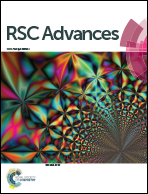Rapid synthesis of macroporous graphene oxide/poly(acrylic acid-co-acrylamide) nanocomposite hydrogels with pH-sensitive behavior by frontal polymerization
Abstract
Macroporous pH-sensitive graphene oxide (GO)/poly(acrylic acid-co-acrylamide) (PAA) nanocomposite hydrogels were prepared by frontal polymerization (FP) using a solvent mixture composed of DMF and a small quantity of GO water solution as a heat conductive medium. A flat frontal can be obtained. The high temperature on the propagating front evaporated water to produce many vapor bubbles, which were trapped into the hydrogel matrix and consequently formed a macroporous structure (i.e. diameter ca. 120 μm). The increase in the concentration of GO solution led to an increase in front velocity (Vf) and the highest front temperature (Tmax). Fourier transform infrared spectroscopy (FTIR) and X-ray diffraction (XRD) indicated that GO nanosheets were crosslinked into the PAA hydrogel. Scanning electron microscope (SEM) analysis illustrated that the size of pores in GO/PAA nanocomposite hydrogels highly depended on the concentration of GO solution. The macroporous structure of nanocomposite hydrogels had a significant influence on the pH-sensitive swelling behaviors of the nanocomposite hydrogels. The highest compressive strength of the GO/PAA nanocomposite hydrogel can reach 44.9 MPa.


 Please wait while we load your content...
Please wait while we load your content...